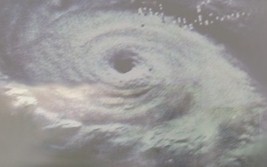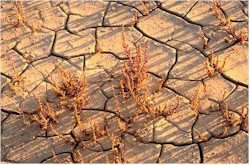|
DESTRUCTION,
DIVERSION, DEFORESTATION, DEVELOPMENT, DIKING, AND DRAINING
Drained
Over many years, as areas have become populated
with human beings that did not realize the significant and important
value of wetlands, the
wetlands were drained for roads, railroads, industry, cropland, housing,
cities, and for controlling mosquitoes.
|
The natural lands
and wetlands were "developed." |
|
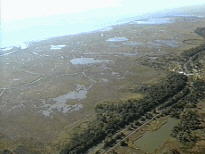 |
|
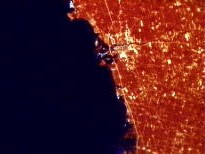 |
|
Natural
wetlands
Coastal (salt water)
Inland (fresh water) |
|
|
Satellite
view of heat coming from dense development along a coastline |
|
Diverted
Wetland waters were also
diverted
via man-made canals to other
areas for agricultural use and to send to cities which kept growing larger and
larger.
|
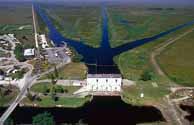 |
 |
|
|
Alteration
of the natural water systems in Florida
Picture credits: South
Florida Water Mgmt Dist |
Every home
on a waterway |
|
Converted
Some wetlands were
converted
to aquaculture for controlled growing of fish, shellfish, mollusks
(oysters, mussels, clams), crustaceans (lobsters, shrimp, crabs), and
seaweed.
|
Natural habitats were polluted and
destroyed |
DESTRUCTION OF HABITAT AND
PLANT SPECIES
Trees and shrubs in mangrove swamps have been cut down, and whole
ecosystems changed for aquaculture. With the
root systems of water plants and woody plants gone,
coastal soils have eroded and been washed away.
In some areas, mangrove forests have been completely cleared
and totally destroyed for urban development.
Mangrove swamps
are saltwater swamps
that lie along tropical and subtropical seacoasts.
Mangrove
forests provide a great variety of
important functions that help
maintain a healthy
coastal area.
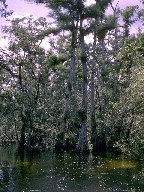
|
Mangroves provide a multitude of
vital and complex services, such as:
- Protect
coastlines during severe weather
-
Prevent erosion of soil from wave action
-
Filter chemicals and nutrients in water
-
Nursery for fish, crustaceans, and shellfish
-
Provide nesting areas for birds
-
Habitat and shelter in roots and branches
-
Reduce damage from floods
-
Mangroves are
very important to major food
webs in coastal communities.
|
|
Their unique root systems keep
the soil from being washed away by waves during storms.
This picture explains
why these mangroves are known as "walking trees." |
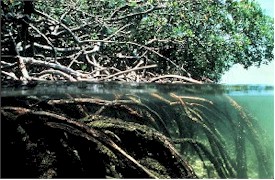 |
|
Most tropical countries have lost more than half
of their mangrove forests to logging, urban
development, or conversion to rice fields,
cropland or fish-farming ponds. |
|
DESTRUCTION FROM DEFORESTATION
AND DEVELOPMENT
Commercial deforestation and
development in wetland areas have resulted in significant declines in
habitat, species populations, and critical ecosystem functions.
This destruction continues in unregulated regions of the world.
TOXIC POLLUTION OF WETLANDS AND WILDLIFE
Along with the destruction
of wetlands, human beings added pesticides and pollution, so over the
years wildlife and bird populations greatly declined.
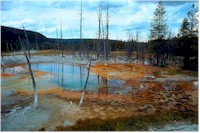
DECLINE OF WATER SOURCES AND WETLANDS FUNCTIONS
Critical water changes occurred with alteration of wetlands; water
tables dropped and wetland vegetation water filtration was no longer
available to purify the wastes of civilization.
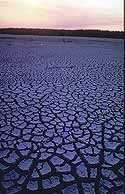 |
Loss of water
from various changes, led to inability of wetlands areas to
maintain through normal dry periods.
Picture
credit: South Florida Water Management District |
CHANGES TO ECOSYSTEMS AND WEATHER
In some areas,
weather even changed. As the wetlands were converted
for all the various reasons, natural
wetland ecosystems drastically changed or disappeared entirely.
|
Many
species were left without life-support systems. |
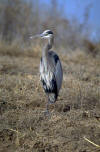 |
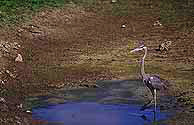
Great Blue Heron
in dried-out canal
Credit: South Florida
Water Mgmt Dist |
|
Great Blue Heron
Click on picture on left side to enlarge it
Click on link to learn about this species |
DECLINE AND LOSS OF
NATIVE AND MIGRATORY SPECIES
|
Some resident
native mammals, nesting birds, amphibians, insects, reptiles
and organisms which inhabited the wetlands have been lost or
seriously impacted.
|
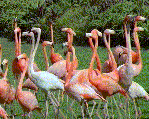
Flamingos |
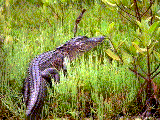
American Crocodile |
Migrating birds
in great numbers had to fly farther and longer looking for
other wetlands, as their food sources were no longer
available to them for their long flights. Flamingos
have been known to fly up to 373 miles (600km) each night to
get to another wetland habitat |
|
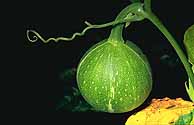
Young Okeechobee Gourd Plant |
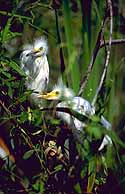
Young Egrets |
|
Some species
are unable to leave when their habitats can no longer
support them - such as crawling insects, plants,
flowers, and young wildlife. |
DISPLACEMENT OF PEOPLE
People who lived in wetland areas no longer had the natural wetlands as
sources of food for themselves and their families, and as sources of
income - so they had to move away.
|
Ecosystems and species
became "at-risk" |
|
Along with
the losses of natural habitat, native and
migratory species, wetland ecosystem functions,
and the displacement of people - many
areas also lost much of the natural protections
that had been provided by barrier islands and
various types of natural wetlands (i.e., the
loss of spongy soils, marsh grasses, forests,
and root systems of coastal and inland aquatic
plants).
|
|
With many of
the natural protections and buffers gone,
the lands were left more vulnerable to damage from
severe weather, floods, tsunamis, and hurricanes.
Click into the
links below to read about what happened
to two major wetlands systems in
different parts of the world. Both
of these wetland ecosystems had evolved
over thousands of years, building up
resistance for survival (as species do
over long periods of time). Then
humans began changing nature's good
works to meet their growing needs, and
the wetlands were weakened and left more
vulnerable. We are now learning
better ways to meet humanity's needs, while
taking care not to disrupt the natural
environmental systems. This is what we
have to do - Earth's natural systems support
life! |
|














